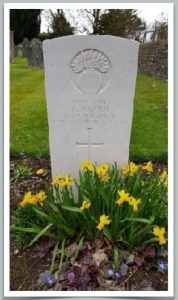2nd Battalion, Grenadier Guards

George Ingram was a farm labourer, who became a policeman prior to enlisting in the Army and who died of wounds received during the Battle of the Somme.
He was born on 6 August 1891 at Shorncote (situated halfway between Kemble and South Cerney). In the census returns for 1901 and 1911, he is shown as living with his grandparents, Elias and Mary Ann Ingram, at Ewen Wharf, Kemble.
Baptismal record for Shorncote Parish Church show that Elias & Mary had three of their children (ages ranging from 5 to 13) baptised on 11 October 1891. Also baptised that day was George, who it was noted, was the son of Sarah Ingram a ‘single woman’. Sarah was one of Elias and Mary Ann’s children. It would appear, therefore, that George was illegitimate.
After leaving school George worked on a farm as a labourer and on 1 May 1912 he joined the Gloucestershire Constabulary, as a Constable and was given the Warrant No 3997. Four months later he was then posted to the Stow Division and later transferred to the Gloucester Division.
On 7 September 1914 he resigned from the police orce, to allow him to voluntarily enlist in the Army.
He was posted to the 2nd Battalion, Grenadier Guards and was allocated the number 18519. Later he was promoted to Lance Corporal.
Unfortunately, no Army Service or Pension Record has survived for George but his Medal Index Card and Medal Roll states that he first joined the British Expeditionary Force (BEF) in France and Flanders on 24 May 1915.
The 2nd Grenadiers, as part of 1st Guards Brigade, Guards Division, had been present on the Western Front since mid-August 1914. On 18 May 1915 it took part in an attack near to Le Touret, when a significant number of casualties were sustained, which included the Battalion CO.
Later that year, on 20 August, the battalion became part of 1st Guards Brigade, Guards Division. In mid-October the battalion was took part in an action to capture German positions at the Hohenzollern Redoubt, near to Loos. It is believed that George Ingram came through this unscathed and he was later promoted to Lance Corporal.
On 15 February 1916 George married Ethel Elizabeth Grant at St Mark’s Church, North Audley Street in central London.
The marriage record shows him as being a Lance Corporal in the 2nd Battalion, Grenadiers Guards. Curiously, his father is shown to be ‘Stephen Ingram, (deceased), platelayer’. Given the apparent illegitimate status and the absence of any evidence of his father’s name, possibly this was made up.
In the absence of a Service Record, giving details of any medical treatment given to Lance Corporal Ingram, we must look further into 1916 and the battalion’s involvement in the Somme Offensive.
In September it was involved in a number of actions in the Ginchy and Lesboeufs area. On 15 September an attack was made on the village of Ginchy, where the 2nd Grenadiers were to act as a support battalion following up on an assault by another Guards’ battalion and passing through the village. It lost 127 killed and missing and 232 wounded.
One of the battalion officers wounded in the action was the uture Prime Minister, Harold Macmillan. On 24 September the battalion went into trenches near to the Ginchy-Lesboeufs Road and at 12.35pm on the 25th they attacked.
The assault was held up by uncut wire hidden in fields of crops, undamaged by the supporting barrage and four of the battalion’s officers went forward to cut gaps: three were killed in the process and one wounded. However, the gaps they had created enabled the assault to take place.
By the time the first objective had been secured, casualties had mounted and the assault on the second objective was largely directed by NCOs. This objective was secured by 1.45pm. Casualties amongst the Other Ranks, amounted to 108 killed, 222 wounded and 12 missing. It would appear likely that Lance Corporal Ingram was wounded in either one of these actions.
The Weekly Casualty List published in the Birmingham Post on 6 November 1916 reported him as wounded. He was sent back to England and admitted to
Southmead Hospital, Bristol, where he died of his wounds on 14 October, 1916, aged 25.
He was buried in Kemble Church Churchyard, where a standard CWGC headstone marks his grave. He is also commemorated on the Kemble War Memorial and on the Roll of Honour of men of the Gloucester Police Division who served in the Great War of 1914-1918. When first erected a framed copy hung in the Recreation Room at the Gloucester Police Station.
George Ingram’s widow received a pension following his death. She is believed to have re-married (to a William J Schilder) in early 1919.
Elias and Mary Ann lost their son (George’s uncle), 5331 Private Henry Ingram, killed in action on 22 August 1916, whilst serving with the 1/6th Battalion, Gloucestershire Regiment. He was a regular soldier, who had enlisted in 1899 and has no known grave and is commemorated on the Thiepval Memorial to the Missing of the 1916 Somme Offensive.
Researched by Graham Adams 9 December 2020 who added: ‘thanks to Bob Brunsdon for his contribution to this biography, particularly as it related to Gloucestershire Constabulary’
